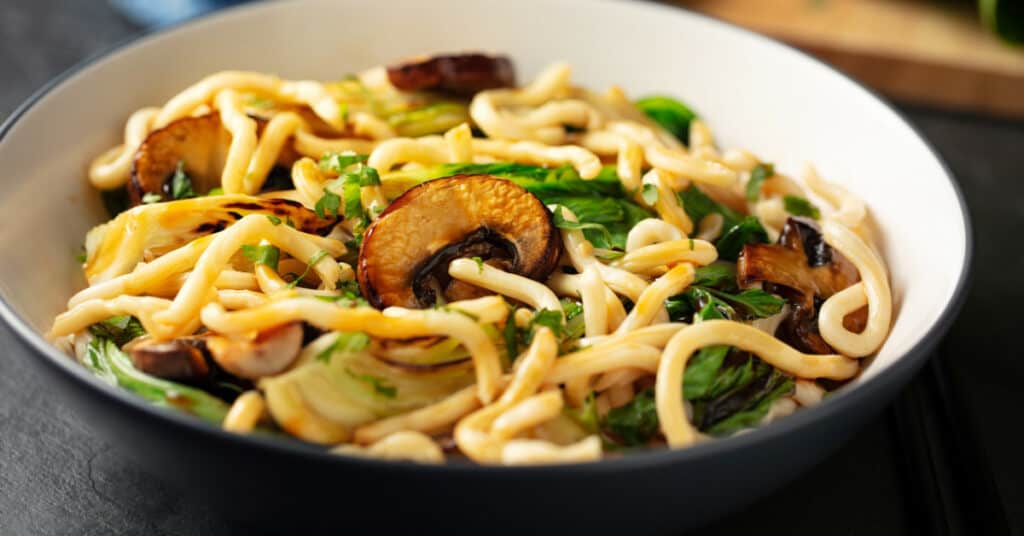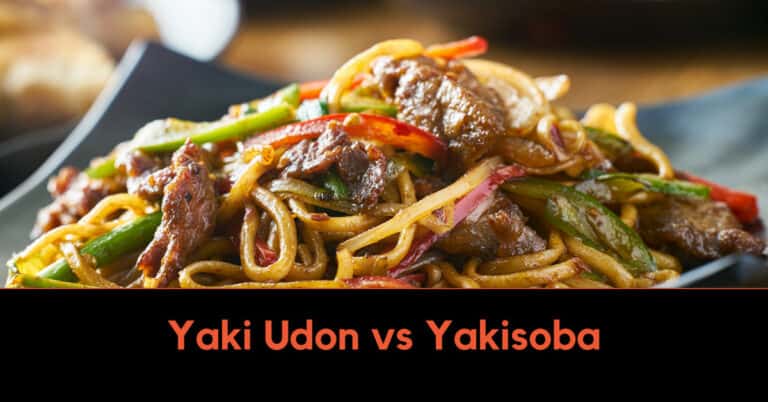SUMMARY: Yaki udon and yakisoba are both delicious Japanese noodle dishes, but they differ in a few key ways. Yaki udon is made with thick and chewy udon noodles, while yakisoba uses thin and curly soba noodles. Additionally, yaki udon is often stir-fried with soy sauce and various vegetables. At the same time, yakisoba is typically cooked with a tangy Worcestershire-based sauce and garnished with pickled ginger and green onions.
Are you craving a mouthwatering Japanese noodle dish torn between yaki udon and yakisoba?
Indulge in this ultimate showdown as we delve into the battle of flavors, textures, and ingredients, comparing Yaki udon vs Yakisoba. In this article, we will explore:
- The distinctive features of yaki udon and yakisoba
- A detailed analysis of the textures, sauces, and seasonings that set them apart
- Frequently Asked Questions about these popular Japanese noodle dishes
So, whether you’re a noodle aficionado seeking culinary enlightenment or simply needing guidance to satisfy your cravings, join us on this flavorful journey through yaki udon and yakisoba.

Yaki Udon: The Heavyweight Champion
Thick, chewy, and bursting with flavor, yaki udon captivates the taste buds and leaves a lasting impression. Let’s dive into what sets this heavyweight champion apart:
Description of Yaki Udon’s Thick and Chewy Noodles
- Made from wheat flour, yaki udon noodles are thick and satisfyingly chewy.
- The hearty texture of the noodles provides a substantial bite, giving each mouthful a delightful chewiness.
Overview of the Dish’s Ingredients
- Yaki udon typically features a variety of vegetables, such as cabbage, carrots, and bell peppers, adding a vibrant touch of color.
- Meat options like thinly sliced beef, pork, or chicken bring savoriness.
- The stir-fried noodles are tossed in a delicious combination of soy sauce, mirin, and sometimes oyster sauce, creating a perfect umami balance.
Highlighting the Versatility of Yaki Udon
- Yaki udon is a blank canvas for creativity, allowing endless flavor combinations.
- From succulent seafood to earthy mushrooms, the diverse range of ingredients pairs harmoniously with yaki udon, providing endless culinary possibilities.
- Toppings such as bonito flakes, sesame seeds, and pickled ginger add texture and complexity to the dish.
Explore the following section to uncover the surprising kick of yakisoba, the underdog in this culinary clash.
Yakisoba: The Underdog with a Surprising Kick
Yakisoba, although often overshadowed by its heavyweight counterpart, yaki udon, has its own unique qualities that make it a formidable contender in the world of Japanese stir-fry noodle dishes. Here, we explore the distinct characteristics and flavors that set yakisoba apart:
Explanation of Yakisoba’s Thin and Springy Noodles
- Yakisoba features thin and springy noodles that are made from wheat flour.
- These noodles are slightly alkaline and have a bright yellow color.
Discussion of the Dish’s Ingredients
Yakisoba embraces a range of ingredients that give it a distinctive taste:
- Cabbage: One of the key components of yakisoba is shredded cabbage. It adds a delightful crunch and freshness to the dish.
- Pork: While yakisoba is often made with slices of pork, it can also be prepared using other proteins such as chicken, beef, or even tofu as a vegetarian option.
- Worcestershire Sauce: Unlike yaki udon, yakisoba is traditionally seasoned with Worcestershire sauce, which lends its unique tangy and slightly sweet flavor.
- Other Vegetables: Alongside cabbage, yakisoba is commonly cooked with vegetables like onions, carrots, and bean sprouts, adding depth and texture to the stir-fry.
Unique Flavor Profile of Yakisoba Compared to Yaki Udon
Yakisoba stands out from yaki udon due to its distinct flavor profile:
- Tangy and Sweet: The Worcestershire sauce used in yakisoba gives it a tangy and sweet taste that balances well with the savory ingredients.
- Bold and Umami-rich: The combination of pork, vegetables, and sauce creates a satisfying umami flavor that makes yakisoba a crowd-pleaser.

Showdown: The Battle of Textures
When it comes to the battle of yaki udon vs yakisoba, one important factor is the difference in textures. The texture of the noodles can greatly influence the overall eating experience and preference for one dish over the other. Let’s compare and contrast the textures of yaki udon and yakisoba:
Comparison of the Chewiness of Yaki Udon Noodles to the Springiness of Yakisoba Noodles
- Yaki Udon:
- Chewy and thick: Yaki udon noodles are typically thick and chewy, providing a more substantial bite than yakisoba noodles.
- Satisfying mouthfeel: The dense and hearty texture of yaki udon noodles can be incredibly gratifying to chew on, creating a sense of comfort and fullness.
- Yakisoba:
- Thin and springy: Yakisoba noodles have a leaner and springier texture, offering a lighter and more delicate bite than yaki udon.
- Bouncy and flexible: The springiness of yakisoba noodles adds a playful element to each mouthful, making it enjoyable to slurp and savor.
How the Different Textures Affect the Overall Eating Experience
- Yaki Udon:
- Substantial and filling: The chewy texture of yaki udon noodles, combined with the heartiness of the dish’s ingredients, creates a satisfying and filling eating experience.
- Perfect for sauce absorption: The thick and chewy noodles of yaki udon can effectively absorb and hold onto the flavors of the sauce and ingredients, enhancing the overall taste and complexity of the dish.
- Yakisoba:
- Light and lively: The springy texture of yakisoba noodles imparts a sense of lightness and freshness, making it a popular choice for those seeking a lighter option.
- Quick and enjoyable: The bounciness of the noodles, combined with the variety of vegetables and proteins, creates a quick and enjoyable eating experience, where every bite bursts with flavor.
Highlight the Importance of Texture Preference in Choosing Between the Two Dishes
Understanding and considering personal texture preferences can play a significant role in determining whether you lean towards yaki udon or yakisoba:
- Yaki Udon:
- If you enjoy a more substantial and chewy bite and prefer a satisfying and filling dish, yaki udon, with its thick and dense noodles, might be the perfect choice.
- Yakisoba:
- Suppose you prefer a lighter, bouncier texture and enjoy a playful and lively eating experience. In that case, the springy yakisoba noodles may suit your liking.
In the next section, we will delve into the clash of flavors, focusing on the sauces and seasonings used in yaki udon and yakisoba.
Flavor Clash: Sauce and Seasonings
The clash of flavors between yaki udon and yakisoba goes beyond just the noodles. The sauces and seasonings used in these dishes significantly contribute to their distinct tastes. Let’s uncover the flavors that make each dish unique:
Contrast the Flavors of the Sauces Used in Yaki Udon and Yakisoba
- Yaki Udon:
- Soy-based sauce: Yaki udon is typically seasoned with a soy-based sauce that adds a savory and slightly salty flavor.
- Umami-rich broth: The sauce used in yaki udon often incorporates ingredients like dashi (Japanese soup stock) or mirin (sweet rice wine), elevating its umami profile.
- Yakisoba:
- Worcestershire sauce: Unlike yaki udon, yakisoba is traditionally seasoned with Worcestershire sauce, which imparts a tangy, slightly sweet, and savory taste. The Worcestershire sauce used in yakisoba in Japan is different from the Western version, having a unique blend of flavors.
Discussion of the Impact of the Sauces on the Overall Taste of the Dishes
- Yaki Udon:
- Savory and rich: The soy-based sauce used in yaki udon brings a deep and rich umami flavor to the entire dish, complementing the chewy noodles and various ingredients.
- Balancing act: The sauce helps bring together the flavors of the vegetables, meat, and noodles, creating a harmonious blend that is both satisfying and comforting.
- Yakisoba:
- Tangy and sweet: The Worcestershire sauce adds a distinct tanginess and subtle sweetness to the yakisoba, making it a flavorsome and dynamic dish.
- A unique fusion of flavors: Combining Worcestershire sauce with the other seasonings in yakisoba creates a complex and engaging taste that stands out from other stir-fried noodles.
Explanation of the Variety of Seasonings and Toppings that Enhance the Flavors of Both Dishes
- Yaki Udon:
- Additional seasonings: Yaki udon can be further enhanced with additional seasonings such as sesame oil, oyster sauce, or chili sauce, depending on personal preference.
- Tasty toppings: Common toppings for yaki udon include green onions, sesame seeds, nori (seaweed), or bonito flakes, which add flavor and visual appeal to the dish.
- Yakisoba:
- Flavorful add-ons: Yakisoba can be customized with various toppings and seasonings like pickled ginger, aonori (green seaweed), katsuobushi (bonito flakes), or beni shoga (red pickled ginger), allowing for a more diverse taste experience.
- Spice it up: Some people enjoy adding a touch of spicy mustard or mayonnaise to their yakisoba for an extra kick of flavor.
In the next section, we will summarize the key differences between yaki udon and yakisoba and encourage readers to try both dishes to discover their personal favorite.
Key Takeaways
In conclusion, yaki udon and yakisoba are delicious and popular Japanese noodle dishes with unique characteristics that set them apart. Here are the key takeaways from this article:
- Yaki udon features thick and chewy noodles, while yakisoba is made with thin and springy noodles.
- Yaki udon offers a versatile range of flavors and toppings, allowing for customization to individual preferences.
- Yakisoba has a distinct flavor profile thanks to cabbage, pork, and Worcestershire sauce.
- Texture preference plays a crucial role in choosing between yaki udon and yakisoba, with yaki udon being chewier and yakisoba having a springier texture.
- The sauces used in yaki udon and yakisoba contribute significantly to the overall taste of the dishes.
- Both dishes offer a variety of seasonings and toppings to enhance their flavors.
We encourage our readers to embrace their adventurous side and try both yaki udon and yakisoba to discover their personal favorite. Packed with unique flavors and exciting textures, these dishes will satisfy any noodle lover’s cravings.
FAQs: Yaki Udon vs Yakisoba
What is the main difference between yaki udon and yakisoba?
The main difference lies in the type of noodles used – yaki udon features thick and chewy udon noodles. At the same time, yakisoba is made with thin and springy soba noodles. Additionally, the ingredients and flavor profiles of the two dishes differ slightly, giving them their distinctive tastes.
Can yaki udon or yakisoba be made vegetarian or vegan?
Yes, both yaki udon and yakisoba can be made vegetarian or vegan. Simply substitute the meat with tofu or soy-based protein, and use vegetarian-friendly sauces and seasonings. It’s a great way to enjoy these dishes while adhering to dietary preferences or restrictions.
Can I substitute the noodles in yaki udon or yakisoba with a different type?
While traditionally, yaki udon is made with udon noodles and yakisoba with soba noodles, you can experiment with different types of noodles if you prefer. Just keep in mind that it may alter the overall taste and texture of the dish.
Are yaki udon and yakisoba considered healthy dishes?
Yaki udon and yakisoba can be considered relatively healthy dishes, as they typically contain a variety of vegetables and protein. However, the overall healthiness depends on the cooking method and the specific ingredients used. It’s always a good idea to enjoy them in moderation as part of a balanced diet.
Which dish is more popular in Japan?
Both yaki udon and yakisoba are popular dishes in Japan, and their popularity may vary depending on the region. However, yakisoba is often associated with festivals, street food vendors, and casual dining, which has contributed to its widespread recognition both in Japan and internationally.

